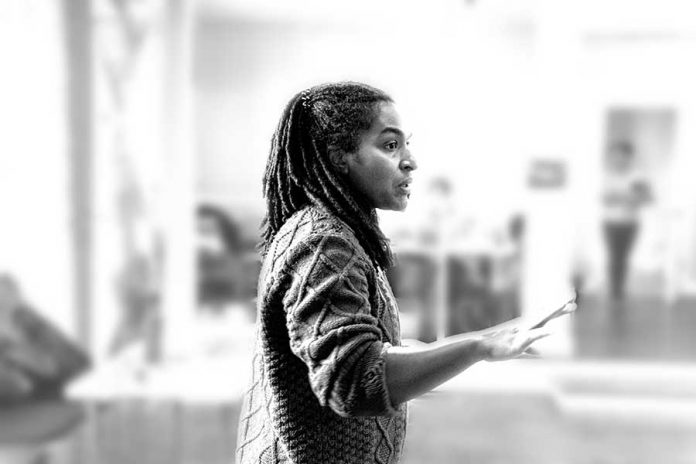Contemporary theatergoers might not recognize the 1915 play “Rachel” or the name of its author, Angelina Weld Grimké. The work, while obscure today, was revolutionary in its time. At its premiere, it was the first piece of theater with an all-Black cast to be performed before an integrated audience. Grimké — a queer woman of color who also worked as a journalist and poet — was also interested in crafting a work with political dimensions, in line with the trend of agitprop theater popular at the time.
“Rachel” receives a much-belated Philadelphia premiere this month at Mt. Airy’s Quintessence Theatre, where it runs through Feb. 16. At the helm of the production is Alexandra Espinoza, an out theater artist who has already found success in Philadelphia as a performer, playwright and dramaturg.
PGN recently spoke with Espinoza about connecting the themes of “Rachel” to the present moment in history, as well as performing works about Black life and experience for predominantly white audiences. Some responses have been condensed and edited for clarity.
“Rachel” is probably not as familiar a title as some of the other plays Quintessence has presented. Can you talk a little about the play’s background?
The play is a propaganda play, which was a style that was pretty popular in the early 20th century. It was written specifically as an anti-lynching play, actually in direct response to the film “Birth of a Nation.” Its early life was actually more literary, since Angelina Grimké actually has more of a literary legacy. She was quite a prolific poet and essayist. The play was actually first published before it was produced in “Crisis,” which was the NAACP’s newspaper. The editor-in-chief of that newspaper was W. E. B. Du Bois. In terms of its position historically, I think it’s just a really great example of the intersection of art and politics at that moment. The other thing that’s true about the play in terms of its production history is that it’s the first play produced with an all-Black cast for an integrated audience. Some of that shows in the way it was written. A lot of what I think Grimké is going for is an argument about humanity.
As a director, what are some of the things you’ve been considering as you prepare to present this play to a 2020 audience?
I am also a performer, so knowing the history of the play — being something that was written for a white audience in a lot of ways — that was something I wasn’t super comfortable with at first. Even in working with new plays, it can sometimes feel like the Black experience is used as a lesson or a parable for white audiences. That can feel pretty isolating for the people onstage. As a director, my top priority when we started was to figure out what this play does for us, and how do we make it ours. What that has turned into is that the play in its current form, in our production, is really about a family. It’s about people who make choices. It’s about people who are forced by their society to make incredibly hard choices, but who do so in a very human way. That’s been the biggest charge for me: I want this piece to exist primarily for the people making it.
Grimké was known to be queer in her personal life. Does that influence the play too?
I am also queer, so for me, absolutely. And that was a really big draw to want to work on the piece. In a lot of ways, she did a lot of hiding in plain sight. She [Grimké] was also someone who could have probably passed for white but did not. I think the structure of the piece in a lot of ways hides in plain sight, which is exciting for me. I think maybe in someone else’s hands, certain aspects of the piece might read differently. But just because of my personal experiences, I do see it as a queer story. And I think it’s actually queer in a very contemporary way, just because of how the definition of queerness is expanding in the 21st century. She’s really questioning institutions, including the institution of marriage, in the face of a world that offers so few choices. In that way, it is very queer and very refreshingly political in its queerness. I think this play encompasses the political agency that queerness is part of.
How do you balance your life as a performer, writer and director?
I think the easiest way to answer that question is that ultimately, what I love is storytelling. The role I play in storytelling changes based on the story. There are always logistical challenges. I try and pay attention to what I miss most when I’m doing something else, and I try to follow my gut in that way. It’s still a puzzle and I’m trying to figure it out.
How did you start out?
I would say in theater, I started out as a performer, but I’ve always been a writer. I actually came to theater as a career relatively late. I thought I would actually do human rights law or academics as a history specialist. It took me some time to listen to what I actually wanted, but in all of the other iterations of what I was doing, I was always writing. Writing has just always been a part of what I do, but performing was always my favorite hobby. I just streamlined things. In terms of directing, I’ve done a lot of dramaturgy and directing readings and workshops. In a lot of ways, this production is a first that doesn’t feel like a first as much as I thought it was. Directing is so play-dependant. For me, I think the best thing to direct is something I have a lot of love for, but that I don’t think is perfect. Or something that I think hasn’t been seen from a certain perspective. In that way, I think a play like “Rachel” is a perfect fit.
For tickets and information about “Rachel,” please visit quintessencetheatre.org.

